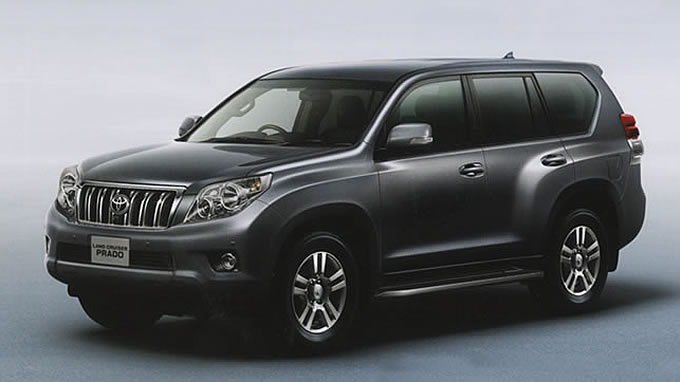The Land Cruiser Prado (known as the Land Cruiser in North America) is trusted and in use worldwide
Since the introduction of the first Prado (70 series) in 1990 to the present, the Land Cruiser Prado has evolved through generational changes to the 90 series, 120 series, and 150 series. Each model has its own characteristics, and its popularity cannot be expressed in a single word.
However, as a member of the Land Cruiser family that has been recognized and sold worldwide, the greatest attraction shared by all is its high level of reliability and overall driving performance. As a wagon derived from the Land Cruiser 70 series van, which is the successor to the heavy-duty Land Cruiser 40 series, it has evolved with a shift towards a more comfortable passenger car.
Luxury or not, at the root of this vehicle there is still a Land Cruiser. There are some hard core Land Cruiser enthusiasts who say that the Prado after the Land Cruiser 90 series, which shares the chassis with the Hilux Surf, is not a real Land Cruiser. The Prado became independent of the Land Cruiser 70 series and is recognized worldwide. In Japan, in addition to its performance as a 4WD, its size and utility, which are suitable for road conditions and garage sizes, are highly valued, and there is a steady supply of used vehicles.
Let’s take a look at the features and appeal of successive Land Cruiser Prado models.
Overview of Land Cruiser Prado

Predecessor of Prado: Land Cruiser 70 Wagon (1985-1990)
The vehicle in the photo is not the Prado, but it is the Land Cruiser 70 Wagon, an important model that triggered the incarnation of the Prado. This model was the first wagon registration (5-number) model in the history of Land Cruiser and was the predecessor of the later 70 series Prado. While maintaining the heavy-duty image of the Land Cruiser 70 series van, the suspension is coiled to improve ride comfort mainly on-road. The engine is equipped with a 2.4-liter inline 4-cylinder diesel turbo and was only available with a 5-speed manual transmission.
5-number cars had advantages over registered vans in terms of cost, such as vehicle inspection periods, but at that time, the first Japanese 4WD coil spring + rigid axle type suspension’s running performance attracted more attention than the fact that it was a wagon.
Because vans were required to have a certain amount of luggage room, as a wagon, the Land Cruiser 70 was not bound by those rules. It offered ample legroom and reclining rear seats, which gave it an advantage when it came to comfort. While it is a rare vehicle today, it played a very important role in the development of the Prado.

Land Cruiser 70 Prado (1990-1996), the first model bearing the name of “Prado”
The Land Cruiser 70 series wagon underwent a major change, was given a dedicated front design, was named “Prado” (Japan only) and is a memorable model that charted its own course.
Toyota added an 8-seat/4-door model, as well as an automatic transmission, which made it familiar to all drivers, and that attracted a lot of buyers. In addition, through the addition of a wide-fender model (3-number car) and changes such as installing a more powerful engine, the unpopular 70 series wagon changed completely, which transformed the Prado into a very popular vehicle. It had a 2.4-liter in-line 4 diesel turbo engine with electronic control, and the transmission was available as an electronically controlled 4-speed full automatic or as a conventional 5-speed manual.
Ultimately, a more powerful 3-liter straight-4 diesel turbo was installed, which removed the idea that the Prado was weak. In the interior, the dashboard of the late model was more rounded and improvements were made to dispel the truck smell of the previous model, actively promoting differentiation from the van. With these improvements and changes, it is a model that has increased its unique user base, which is different from the conventional 70 series fans.

Land Cruiser 90 Prado with many specifications (1996-2002)
The Land Cruiser 90 Prado is a model in which the Prado, which was one of the 70 series until then, became independent and was given a new model. Many fans remember that it was developed with a strong resemblance to the Mitsubishi Pajero, which was selling well at the time, and the resemblances became a topic of discussion regarding the Prado.
The Prado’s first gasoline engine was added to the domestic specifications, and the late model introduced a new-generation common rail diesel. In addition to this, many groundbreaking improvements were made for cross-country 4WD at the time, such as the independent front suspension. As for the body variations, the 3-door short (90 Prado) and the 5-door long (95 Prado) have a standard (narrow) body and a wide body, respectively, and there were many models, so there were many choices for the 90 series Prado. It was both a feature and an attraction.
In addition to this, there were optional package specifications, camper specifications, and a 5-door long car “5-seater specification”, so there were more than 60 options at the time. The interior was also redesigned, and the instrument panel, which deviated from a work truck appearance, influenced many cross-country 4WDs that followed. The 70 Prado can be said to be an important model that has expanded the base of Land Cruiser users.

The upgraded Land Cruiser 120 Prado (2002-2009)
The Land Cruiser 120 Prado is a model that has been promoted as a luxury model like the Lexus GX470 in North America. Compared to its predecessor, the 90 series Prado, the texture and performance have been improved, and the exterior design has adopted more complex press lines, making the form attractive to the European market, which was its main target.
The addition of electronically controlled components such as H∞-TEMS + rear electronically controlled air suspension with vehicle height adjustment function, 5-speed automatic transmission with AI-SHIFT, VSC (vehicle stability control), active TRC, etc. enhanced its performance.
On the other hand, it is also a model that greatly reflected the times, such as the discontinuation of manual transmissions and the end of the sales of diesel vehicles. The two engine choices are a 2.7-liter inline 4 gasoline and a 3.4-liter V6 gasoline.
Since the 90 series, mid-level in-line 4 gasoline vehicles with excellent fuel efficiency have been popular, and the same is true for this 120 Prado. Today, the current second-hand car market is also responsible for selling these mid-level models. In addition, there are many vehicles equipped with a rear manual differential lock, which was an option at the time, recommended for off-road fans. It can be said that the beauty of the Land Cruiser is that it does not rely on electronic control for everything.

Advanced technology, Land Cruiser 150 Prado (2009- )
The Land Cruiser 150 Prado has matured enough that it is now distinct from the 120 Prado because of its premium features. The 3-door short car for the domestic market was discontinued and only the 5-door long wide body was available, but the most notable point is the return of the diesel model for the first time in about eight years.
The latest technology advanced the vehicle even further as it adopted a 5-speed automatic transmission equipped with a sequential shiftmatic, setting an improved Kinetic Dynamic Suspension System (KDSS), and “multi-terrain select” where you can choose a driving mode according to the road conditions. It is equipped with many advanced features like the “multi-terrain monitor” that allows you to check the surrounding road conditions via an in-vehicle camera.
The current lineup includes a 2.7-liter straight-4 gasoline engine (6-speed automatic), which has been further powered up since the 120 series era, and a newly developed 2.8-liter straight-4 DOHC diesel turbo. At the same time as the diesel revival, the 4-liter V6 gasoline 1GR-FE type was discontinued only for the domestic market. Seven years after its debut, the current model 150 Prado has reached maturity. There are building expectations that there will be a new model soon.




